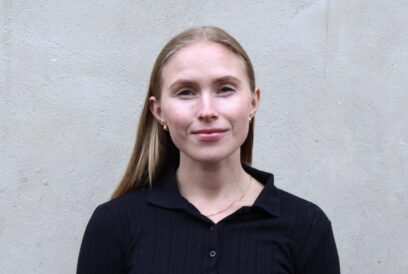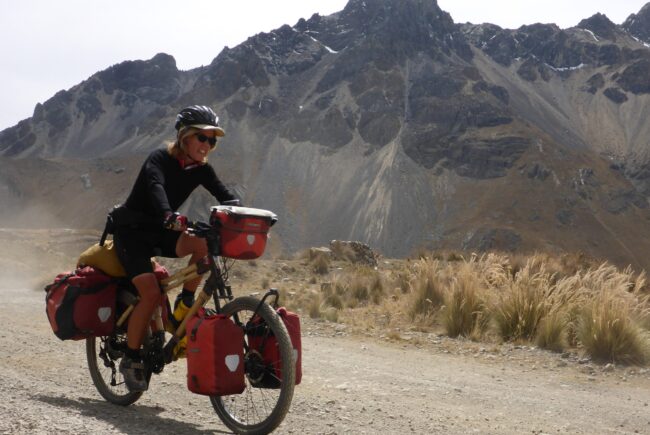

Kate Rawles cycled from Cartagena in Columbia to Ushuaia in Southern Patagonia on a bamboo bicycle she had built herself.
13 months on a bamboo bike: Using adventure to inspire environmental action
Published:Kate Rawles cycled from Cartagena in Columbia to Ushuaia in Southern Patagonia on a bamboo bicycle she had built herself.
Kate Rawles is a lecturer turned activist who cycled 8,000 miles to raise awareness about the loss of biodiversity.
It is spring in Cumbria, Northern England. Everything is blooming, and the lakes and mountains in the area are simply calling people for a long walk or bike ride.
A local environmentalist Kate Rawles, however, is spending a lot of her time indoors. She is not too happy about it.
“It does not fit me very well. But I am trying to write this book and the deadline is approaching, so for now, I am stuck here in my study,” Rawles says on a Zoom call and laughs.
The book Rawles is talking about, The Life Cycle; 8,000 miles in the Andes by bamboo bike (to be published by Icon Books in spring 2022) will tell the story of her extremely ambitious bike ride across South America, which she finished a couple of years ago.
The overall aim of the trip was to raise awareness of, and learn more about, loss of biodiversity. This is an urgent global issue, which can have huge implications for humanity but has so far received much less attention than climate change.
“Biodiversity refers to the diversity of habitats and the diversity of species, and one of the fabulous things about the ride was that crossing a whole continent took me through and across rain forests, the Pacific coastline, deserts, high spiky snowy mountains and salt plains. The ride was about not only understanding biodiversity on an intellectual level, but actually experiencing it,” Rawles says.
Along the 8,288 miles that Rawles cycled from Cartagena in Columbia to Ushuaia in Southern Patagonia, she met with as many people working to protect biodiversity as possible, from small community groups and activists to government officials.

Along her bike ride across South America, Kate Rawles stopped to visit local schoolchildren in Peru. It is easy to meet people when you are on a bike, Rawles finds.
Altogether the trip took a year and half, 13 months of which Rawles spent cycling. She also travelled to South America and back to the UK on a cargo ship to keep the carbon emissions of her trip as low as possible.
Part of the experience was that Rawles completed the trip on bamboo bicycle she had built herself. There was quite a lot of scepticism about whether the bamboo bike – named Woody – would endure the long trip, Rawles admits.
“But Woody ended up being the most reliable bike I have ever had. It didn’t break down once.”
Exploring adventure as a metaphor
A former university lecturer, first in environmental philosophy and then outdoor education, nowadays Rawles is a freelance writer and a popular public speaker who uses adventure to inspire action on major environmental challenges.
Things started to shift in 2006, whilst Rawles was still working at the University of Cumbria and growing increasingly frustrated by how little was being done to fight climate change despite the exhausting amount of data and scientific knowledge available about the issue.
Rawles believes in finding a connection between something one loves doing and something the world needs.
She decided to take some time out of the university and use the time to cycle from Texas to Alaska. The idea did not come out of nowhere – Rawles has loved cycling since she was a child.
One of her favourite things about travelling by bike, Rawles says, is how one can really be in the landscape, rather than sitting in a box as you do with a car. It is also very easy to interact with people when you are on a bike, she finds.
Most importantly, Rawles believes in finding a connection between something one loves doing and something the world needs.
“I think this is the key to being happy and more effective in what you do.”
Following this thought, once she was back from her first long bike ride, Rawles started giving talks about her trip. They included lots of photos she had taken, and were pitched to audiences that might not go to a lecture about climate change.

The map shows the route Kate Rawles followed during the cycling journey, which took 13 months to complete.
Something about the mix of adventurous tales and environmental issues obviously worked. Over ten years later, Rawles is still asked to give these talks. She now speaks to various audiences, visiting cycling events, book festivals and community groups.
Rawles likes to bring humour into her talks and wants to steer clear of judging or guilt tripping people. Yet, she believes that people want to hear the truth, which is that everything will not be fine, unless we as a society bring about deeper systemic change. Playing around the edges and doing “good green deeds” is not enough, Rawles emphasises.
Since her first cycle trip, Rawles has become increasingly interested in how adventure can be used as a metaphor for exploring a more sustainable way of life.
“Thinking about these changes we need can be quite daunting, and we don’t quite kshe has learned that it is not uncommon for activists standing up against extractive industries to be murdered around the world.now how we’re going to do it. But if you think about it as an adventure into the unknown, it makes it more positive.”
Coming home was the hardest part
A big part of The Life Cycle was hearing and learning from people whose lives had already been hugely impacted by environmental issues.
One of the most harrowing encounters, Rawles explains, was with an activist in northern Columbia, where a global goldmining company wanted to open a huge goldmine.

During her bike ride, Kate Rawles spent most of her nights in a tent. The photo is from the Uyuni Salt Flats in Bolivia.
Gold mining, which many experts agree is one of the most destructive industries in the world, could have severely polluted the water and land in the area for hundreds of years to come. In this case, the local activists managed to stop the mining plans – but two people in their group were murdered in the process.
Rawles says that since then, she has learned that it is not uncommon for activists standing up against extractive industries to be murdered around the world.
“It really brought home how privileged our lives here in the UK are – we depend on these resources, and the people trying to defend their communities against resource extractions might pay for it with their lives.”
Perhaps surprisingly, however, the hardest thing about Rawles’ journey was the coming-home part. After more than a year away, she was obviously happy to see her family and friends but struggled with the other changes.
“During the trip, I was out day and night, and somewhere new every day. It was amazing, and then suddenly it stopped – I was in a house with walls and a lot of stuff, and it was really hard.”

After being out and moving every day for over a year, coming home came as a bit of a shock for Kate Rawles. Flamingos at Laguna Colorada in Bolivia.
At first, being able to take a hot shower every day and eat fresh things such as broccoli was great, Rawles admits. But very quickly the feeling subsided and Rawles felt she lost the deep sense of gratitude she had experienced on the road. When cycling in the middle of a desert, little things such as getting a cup of water from a stranger can make you ecstatic, she says.
Another thing Rawles misses from the trip are birds.
“It was so nice that there were always birds within eyesight, keeping me company. I ended up thinking of them as some sort of ambassadors between the other-than-human and the human world.”
You can find more information about The Life Cycle, The Carbon Cycle and other ‘adventure plus’ journeys on Kate’s website or follow her on twitter or Instagram as @CarbonCycleKate.
Author







